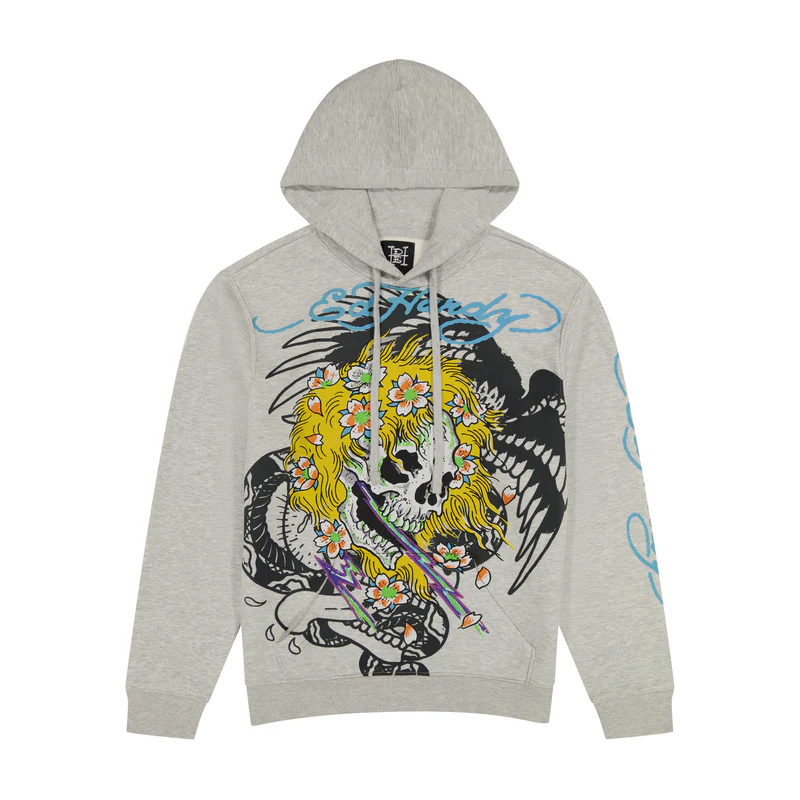Ed Hardy is a name that resonates with anyone who lived through the early 2000s.https://ed-hardy.shop/ Known for its bold and tattoo-inspired designs, the Ed Hardy brand left a lasting impact on pop culture and fashion trends. What started as a unique fusion of tattoo art and fashion quickly became a symbol of luxury, rebellion, and celebrity culture. This article explores how Ed Hardy made its mark on pop culture, revolutionized fashion, and why it continues to hold a significant place in fashion history.
The Birth of Ed Hardy Tattoo Art Meets Fashion
The story of Ed Hardy begins with Don Ed Hardy, a celebrated American tattoo artist who was trained in fine arts. He was one of the first tattoo artists to mix American and Japanese tattoo styles, creating an entirely unique aesthetic. Hardy saw tattooing as a form of artistic expression that could stand on its own merits alongside more traditional forms of art.His tattoo work caught the attention of French fashion designer Christian Audigier in the early 2000s. Audigier saw potential in turning Hardy’s tattoo designs into fashion statements, and the Ed Hardy brand was born. This collaboration between Hardy’s artwork and Audigier’s marketing genius transformed the brand into a global fashion phenomenon. Ed Hardy’s designs brought the intricate and edgy world of tattoo art to mainstream fashion, blurring the lines between body art and clothing.
Celebrity Endorsement The Rise of Ed Hardy in Pop Culture
One of the key reasons behind Ed Hardy’s rapid rise in popularity was its connection to celebrity culture. Audigier understood the power of celebrity endorsements and used them to catapult ed hardy jeans into the spotlight. The brand quickly became synonymous with Hollywood glamour and rebellion. Celebrities like Madonna, Britney Spears, and Paris Hilton were frequently photographed wearing Ed Hardy apparel, which helped cement its status as a luxury brand.These celebrities not only wore Ed Hardy clothing but also embodied the brand’s bold and rebellious attitude. This association made the brand desirable to the public, as people wanted to emulate the edgy and glamorous lifestyle of their favorite stars. The frequent appearance of Ed Hardy gear on reality TV shows like Jersey Shore and The Simple Life made the brand even more visible, particularly among younger audiences.The association with high-profile celebrities was a key marketing strategy that made Ed Hardy not just a clothing line but a symbol of status and style. The brand’s visibility in popular media created a cultural phenomenon that made tattoos more acceptable and fashionable, even among those who had never considered getting inked themselves.
Ed Hardy’s Role in Shaping Early 2000s Fashion
In the early 2000s, fashion was undergoing a dramatic shift. The era saw the rise of streetwear, a style rooted in urban culture and characterized by bold, statement-making clothing. Ed Hardy was perfectly positioned to tap into this movement with its graphic-heavy designs, often featuring skulls, tigers, and roses, elements that were traditionally associated with tattoos.What set Ed Hardy apart was its ability to merge streetwear aesthetics with luxury fashion. The brand’s clothing was often expensive, exclusive, and featured intricate designs that mimicked tattoo art. This combination appealed to fashion-forward individuals who wanted to make a bold statement with their clothing. Wearing Ed Hardy became a way for people to express their individuality and align themselves with the brand’s rebellious image.Ed Hardy’s success also highlighted the growing influence of street culture on high fashion. The brand was able to take something as niche as tattoo art and make it desirable to a mass market. Its designs became a staple in streetwear culture, and its impact can still be seen today in the fashion industry’s ongoing embrace of graphic and tattoo-inspired clothing.
The Ed Hardy Aesthetic A Bold and Lasting Influence
The aesthetic of Ed Hardy clothing is unmistakable—vivid colors, bold designs, and intricate details. The brand’s pieces often featured tattoo motifs like koi fish, dragons, skulls, and roses, symbols that had deep meanings within tattoo culture. These elements were not just decorative; they represented rebellion, strength, and individuality, which resonated with consumers who wanted to stand out.The Ed Hardy aesthetic also played a role in breaking down the barriers between high fashion and streetwear. The brand made it acceptable to wear clothing that was loud, flashy, and rooted in subculture. This was a stark contrast to the minimalism that had dominated fashion in the 1990s. Ed Hardy’s designs were unapologetically bold, and this boldness appealed to people who wanted to express their personal style in a dramatic way.Even after the brand’s popularity declined in the late 2000s, its aesthetic influence continued to be felt. Many of today’s streetwear brands incorporate similar graphic elements and tattoo-inspired designs, proving that Ed Hardy’s impact on fashion has endured. The brand’s legacy lives on in the ongoing trend of mixing bold, artistic designs with casual, everyday clothing.
The Decline and Resurgence of Ed Hardy
By the late 2000s, Ed Hardy’s popularity began to wane. Several factors contributed to this decline. For one, the brand became oversaturated, with its designs appearing on everything from T-shirts to home decor. The sheer ubiquity of Ed Hardy products, combined with the rise of counterfeit goods, diluted its exclusive, luxury image. What was once seen as a symbol of high-end fashion became overexposed and lost its allure.Moreover, the fashion industry as a whole was shifting towards more minimalist styles, leaving Ed Hardy’s bold and flamboyant designs feeling outdated. The brand, once associated with cutting-edge style, became synonymous with the excesses of the 2000s. As a result, Ed Hardy’s popularity dwindled, and it faded from the fashion mainstream.However, fashion is cyclical, and in recent years, there has been a resurgence of interest in early 2000s fashion, including the Ed Hardy brand. Nostalgia for the era, combined with a renewed appreciation for bold and graphic designs, has led to a revival of Ed Hardy’s iconic aesthetic. Younger generations, who may have missed the brand’s original heyday, are discovering Ed Hardy for the first time, and its designs are once again finding their way into pop culture.This resurgence has also been fueled by the rise of vintage and secondhand fashion, where Ed Hardy pieces are highly sought after. The brand’s original designs are now considered iconic relics of early 2000s fashion, and many people are eager to get their hands on these pieces as part of the broader Y2K fashion revival.
Ed Hardy’s Lasting Legacy
Though Ed Hardy may no longer dominate the fashion world as it did in the 2000s, its impact on pop culture and fashion trends is undeniable. The brand played a pivotal role in popularizing tattoo art and bringing it into the mainstream. It also helped blur the lines between high fashion and streetwear, paving the way for other brands to experiment with bold, artistic designs.More than anything, Ed Hardy is remembered for its role in shaping the fashion and pop culture of the early 2000s. The brand became a symbol of the excess, glamour, and rebellious spirit of the time, and its influence can still be felt in today’s fashion landscape. Whether through its bold designs, celebrity endorsements, or its ability to make tattoo art fashionable, Ed Hardy has secured its place in fashion history.In conclusion, Ed Hardy’s impact on pop culture and fashion trends is a testament to the power of innovation and risk-taking in fashion. By merging tattoo art with clothing, the brand created a new and exciting form of self-expression that resonated with people across the globe. While the brand’s popularity may have ebbed and flowed over the years, its influence remains a vital part of the story of modern fashion.

